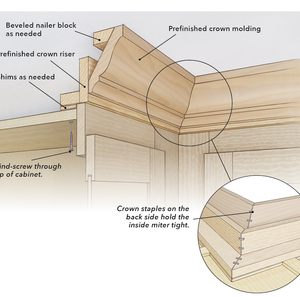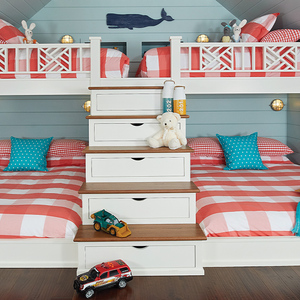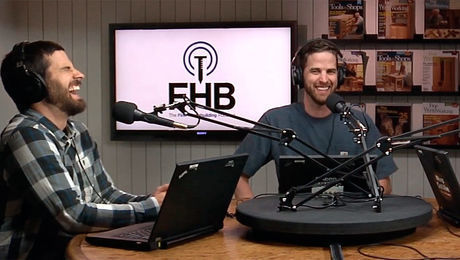Build Better Cabinets With the Best Plywood
Understand veneer-grading and plywood-core options to get the best-quality stock for your next project.

Choosing the right plywood for your next cabinetry project entails more than just picking the species you want and backing your truck up to the loading dock. With plywood prices ranging from $35 for a 4×8 sheet to well into the $100s, you want to make sure you’re spending money where it counts: on structurally sound cores where it matters and on fine veneers where they’re visible.
Core Options
Plywood is commonly available in four different core combinations. Each has unique features that can affect the strength and look of cabinets whether they are stain grade or paint grade.
Veneer core: superior strength, at a price This plywood has multiple layers of thin (usually 1/ 7 in. and thinner) solid wood that’s glued up in a cross-grain orientation. Typical 3/4-in. plywood is made of five 1/ 7-in. core layers and two face veneers. Although this is the strongest of all core options, imperfections in the core veneers can telegraph through to the face veneers, leaving surfaces that are not perfectly smooth. That said, superior strength, screw retention, and light weight make it appealing to work with. Cost: $115-$130*
MDF core: best choice for a smooth finish This plywood has a solid piece of MDF in place of the five core layers in veneer-core plywood. Weight and dust are two downsides, but MDF creates a dead-flat panel that doesn’t have any telegraphing issues. Screw retention is good, though it’s best to drill pilot holes and to use fasteners designed for engineered wood, like Confirmat screws. The edges of MDF-core plywood can be profiled and finished, unlike other plywood that must be edgebanded in most applications. Cost: $100-$115
Particleboard core: cheap, but difficult to work Particleboard-core plywood is similar to MDF-core plywood in both construction and characteristics. The panels are flat, retain fasteners well (with the same caveats as MDF), and are among the least expensive plywood sheets available. However, particleboard-core plywood is the most susceptible to tearout when cutting, routing, or drilling. Cost: $85-$100
Combination core: strong core, smooth face Combination-core plywood consists of a traditional veneer core, except that the outer layers of the core are made of MDF. Combi-core, as it’s often called, offers (almost) the best of both worlds: the smooth, flat faces characteristic of MDF and the strength attributes of veneer core. It’s also only slightly heavier than veneer core. Cost: $100-$115
So which core option is best for me?
There’s little dispute that an MDF core produces the smoothest, flattest surface, making it the best choice where finishing is concerned. Keep in mind that painted plywood is subject to the same considerations as clear-finished or stained plywood. Paint can actually be worse at highlighting irregularities in the plywood face. If you’re looking for an easier material to work with, choose combi-core plywood, which offers nearly the same performance attributes.
*Pricing is based on a 4×8 sheet of 3/4 -in. A1 cherry.
Veneer Options
Plywood veneers are either rotary-cut or sliced. Rotary-cut veneers are produced from the log in the same way you pull tape from a roll. The cut produces a wild, variegated grain pattern that is cost-effective but generally less attractive. Sliced veneer is cut from the log in much the same way a log is cut into lumber, so it yields veneer that mimics solid stock rather well.
Rotary-cut veneer: suitable for painted surfaces and hidden parts Rotary-cut veneer is a perfectly adequate and economical veneer for use on hidden parts of a cabinet, like the back and the drawers. For the exterior and interior faces of painted work, a rotary-cut veneer with a B or better grade is sufficient. Opt for either birch or maple. (See below for an explanation of veneer grading.)
Sliced veneer: best for stained or clear-finished components Of all the ways that sliced veneers can be oriented, you’ll most commonly find bookmatched and random-matched orientations. Bookmatching looks the best in most applications. It has alternating sheets of veneer from a single flitch opened like a book to create a mirrored-grain pattern. Common on back faces, random-match veneers cost the least, but vary in width, color, and grain. Plank-matched veneer is a good option on exposed faces. It’s usually a special order and is laid up in a deliberately mismatched pattern to look more natural.
Plank-matching A plank match mimics the look of edge-glued boards of various widths. It has a less refined look, but is arguably more authentic looking.
Bookmatching This A-grade cherry veneer is bookmatched, so the grain patterns mirror each other across the panel. It’s among the most attractive orientations, particularly for stain-grade cabinets.
Which veneer option is best for me?
For cabinets receiving a clear or stained finish, use a B or better face veneer. For the back veneer, select a 1 or 2 grade, depending on the project. Bookmatched faces look best when the splice is centered on a panel, even if it results in added waste. If a panel is so wide that it includes a second splice line, the mirrored effect becomes lost or muddled. In these cases, a plank match would be a good option. For the inside of the cabinet, a rotary-cut or random-match veneer is perfectly suitable.
Veneer Grading
Veneers from a log are segregated according to appearance into six face grades (AA, A, B, C, D, E) and four back grades (1, 2, 3, 4), with back grades being aesthetically inferior. The best face and back veneers are clear, while successive grades have more noticeable characteristics, such as knots, mineral streaks, and color variation.
Interior Surfaces
To save hours of work finishing the inside of cabinets, opt for a prefinished interior surface. Plywood is available as prefinished 1-side or 2-side stock. For a painted exterior, use prefinished 1-side. Prefinished random-match or rotary-cut maple and birch are usually available at the same prices as unfinished plywood.
Cabinet Backs
Use 1/2-in. prefinished veneer-core plywood in the back of the cabinet for strength and rigidity. Rotary-cut veneer or random-match veneer is perfectly adequate here.
Drawer Boxes
Drawer boxes are typically built with Baltic birch or ApplePly. They are similar products glued up with more layers of wood (18 mm, comparable to 3/4 -in. plywood, is made of 13 layers, for instance) and generally have fewer surface imperfections. Not all grades are clear, however, so it’s worth knowing what you’re buying. Baltic birch is sold in grades B, BB, CP, and C, with more imperfections as you progress down the list. Most of what is used for drawer parts is midgrades sold as “shop birch.” Choose higher grades, or spend less on lower grades and work around the imperfections.


























